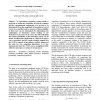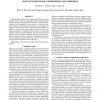24 search results - page 2 / 5 » UML Modelling of Digital Forensic Process Models (DFPMs) |
IEEEARES
2010
IEEE
14 years 6 days ago
2010
IEEE
- An operational complexity model (OCM) is proposed to enable the complexity of both the cognitive and the computational components of a process to be determined. From the complexi...
ICIP
2010
IEEE
13 years 3 months ago
2010
IEEE
Because digital images can be modified with relative ease, considerable effort has been spent developing image forensic algorithms capable of tracing an image's processing hi...
ACSAC
2003
IEEE
13 years 10 months ago
2003
IEEE
Reassembly of fragmented objects from a collection of randomly mixed fragments is a common problem in classical forensics. In this paper we address the digital forensic equivalent...
ARESEC
2011
12 years 5 months ago
2011
—The Operational Complexity Model (OCM) has been used to derive the complexities of the five most prevalent cyber-crimes occurring in southeast Asia, namely peer-to-peer (P2P) mu...
ICIP
2007
IEEE
14 years 7 months ago
2007
IEEE
Multi-user collusion is an cost-effective attack against digital fingerprinting, in which a group of attackers collectively undermine the traitor tracing capability of digital fin...


